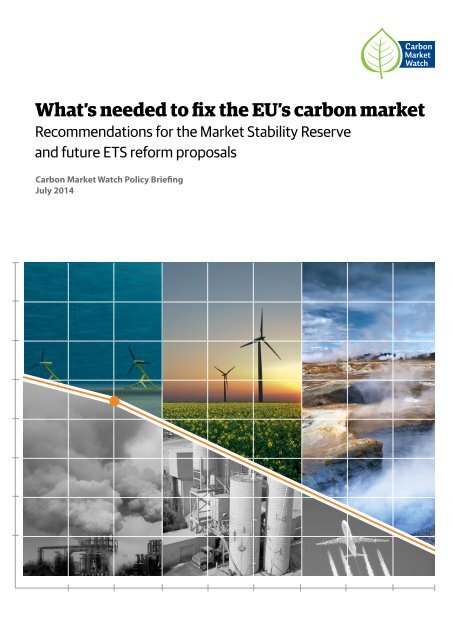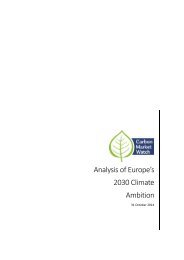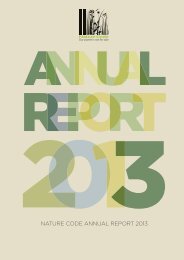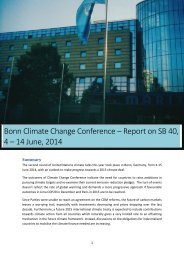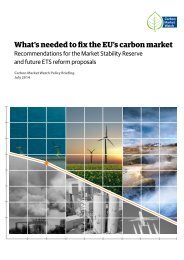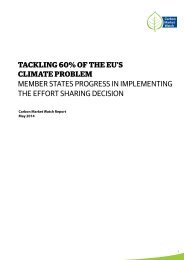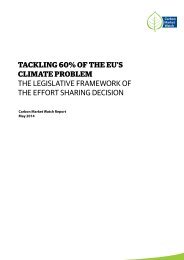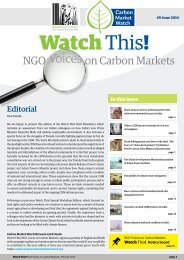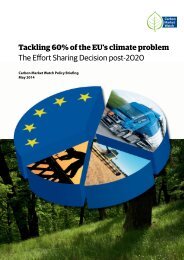What’s needed to fix the EU’s carbon market
You also want an ePaper? Increase the reach of your titles
YUMPU automatically turns print PDFs into web optimized ePapers that Google loves.
<strong>What’s</strong> <strong>needed</strong> <strong>to</strong> <strong>fix</strong> <strong>the</strong> <strong>EU’s</strong> <strong>carbon</strong> <strong>market</strong><br />
Recommendations for <strong>the</strong> Market Stability Reserve<br />
and future ETS reform proposals<br />
Carbon Market Watch Policy Briefing<br />
July 2014
EXECUTIVE SUMMARY<br />
The EU Emissions Trading System (EU ETS) is <strong>the</strong> largest <strong>carbon</strong> <strong>market</strong> in <strong>the</strong> world and was originally seen as <strong>the</strong><br />
corners<strong>to</strong>ne of Europe’s climate policies. However, <strong>the</strong> EU ETS has suffered from a large amount of excess emissions<br />
allowances largely caused by weak emission reduction targets and <strong>the</strong> inflow of <strong>carbon</strong> offsets. This has resulted in<br />
a <strong>carbon</strong> price that is <strong>to</strong>o low <strong>to</strong> promote low-<strong>carbon</strong> solutions.<br />
The EU ETS suffers from credibility issues and an overhaul of <strong>the</strong> system is necessary <strong>to</strong> ensure that <strong>the</strong> EU can<br />
play a leadership role in <strong>the</strong> run up <strong>to</strong> a global climate agreement. In <strong>the</strong> coming years, EU policymakers have <strong>the</strong><br />
chance <strong>to</strong> improve <strong>the</strong> design of <strong>the</strong> <strong>EU’s</strong> <strong>carbon</strong> <strong>market</strong> as <strong>the</strong> proposal <strong>to</strong> enact a <strong>market</strong> stability reserve will be<br />
negotiated and new legislative proposals <strong>to</strong> implement <strong>the</strong> 2030 framework are expected in early 2015.<br />
Measures <strong>to</strong> <strong>fix</strong> <strong>the</strong> problems of <strong>the</strong> EU ETS are necessary <strong>to</strong> set <strong>the</strong> European economy on a path <strong>to</strong> de<strong>carbon</strong>isation<br />
and avoid that future climate targets can be undermined for decades <strong>to</strong> come. Without action, European industry<br />
is at risk of falling behind in deploying low-<strong>carbon</strong> technologies compared <strong>to</strong> <strong>the</strong>ir competi<strong>to</strong>rs abroad. Moreover,<br />
<strong>the</strong> accumulated excess allowances put <strong>the</strong> emission reductions from o<strong>the</strong>r European policies at risk because it is<br />
possible <strong>to</strong> bank <strong>the</strong> unused oversupply of <strong>carbon</strong> allowances for use in <strong>the</strong> post-2020 period. This means that <strong>the</strong><br />
EU ETS is transforming <strong>the</strong> emissions reductions from renewable and efficiency policies in<strong>to</strong> future rights <strong>to</strong> pollute.<br />
The <strong>EU’s</strong> weak emissions targets and <strong>the</strong> huge inflow of international offsets have led <strong>to</strong> an oversupply of <strong>carbon</strong><br />
permits while <strong>the</strong> economic crisis reduced demand for <strong>the</strong>se permits. The surplus in <strong>the</strong> <strong>EU’s</strong> <strong>carbon</strong> <strong>market</strong> amounts<br />
<strong>to</strong> 2.1 billion <strong>to</strong>nnes of CO 2<br />
-equivalent and this surplus is projected <strong>to</strong> increase fur<strong>the</strong>r <strong>to</strong> 2.6 billion <strong>carbon</strong> permits<br />
by 2020 1 which is more than <strong>the</strong> <strong>to</strong>tal <strong>to</strong>nnes of CO 2<br />
emitted in all <strong>the</strong> EU ETS sec<strong>to</strong>rs in a year.<br />
Up <strong>to</strong> 2020, around 1.6 billion international offsets will be used under <strong>the</strong> EU ETS, diverting investments away from<br />
projects that increase <strong>the</strong> competitiveness of European industry and <strong>the</strong> modernisation of Europe’s energy system.<br />
The Commission has proposed <strong>to</strong> exclude <strong>the</strong> use of offsets after 2020, but <strong>the</strong> current use of offsets can still taint<br />
<strong>the</strong> domestic nature of <strong>the</strong> 2030 climate target because it is possible <strong>to</strong> bank allowances between trading periods.<br />
<strong>EU’s</strong> 2030 target <strong>to</strong> reduce domestic emissions by at least 40% could in reality only represent a 34% domestic cut<br />
due <strong>to</strong> <strong>the</strong> surplus being banked in<strong>to</strong> <strong>the</strong> post-2020 period.<br />
An overhaul of <strong>the</strong> EU ETS based on <strong>the</strong> following recommendations is urgently <strong>needed</strong> as <strong>the</strong> EU ETS is currently<br />
cancelling out <strong>the</strong> greenhouse gas reductions from o<strong>the</strong>r existing and future policies and hence does more harm<br />
than good in <strong>the</strong> fight against climate change.<br />
Recommendations <strong>to</strong> <strong>fix</strong> <strong>the</strong> <strong>EU’s</strong> <strong>carbon</strong> <strong>market</strong>:<br />
• Ensure that <strong>the</strong> EU ETS is designed <strong>to</strong> be in line with <strong>the</strong> 2050 objective of reducing emissions by 80-95%<br />
by increasing <strong>the</strong> linear fac<strong>to</strong>r by which <strong>the</strong> ETS cap is annually reduced <strong>to</strong> at least 2.6%.<br />
• Protect <strong>the</strong> domestic nature of <strong>the</strong> 2030 GHG target by removing at least 1.6 billion of <strong>the</strong> excess<br />
allowances.<br />
• Avoid <strong>carbon</strong> price hikes by enacting <strong>the</strong> Market Stability Reserve at <strong>the</strong> earliest possible date (2017).<br />
• Disallow <strong>the</strong> use of international offsets after 2020 as it delays domestic abatement efforts and has not<br />
proven <strong>to</strong> lead <strong>to</strong> real mitigation in host countries.<br />
• Introduce full auctioning for all industrial sec<strong>to</strong>rs post-2020 <strong>to</strong> reflect <strong>the</strong> polluter-pays-principle.<br />
• Establish an EU climate fund <strong>to</strong> be replenished by a portion of <strong>the</strong> ETS auctioning revenues.<br />
2
INTRODUCTION<br />
The EU Emissions Trading System (EU ETS) covers just over 40% of<br />
<strong>the</strong> <strong>EU’s</strong> greenhouse gas emissions. The objective of <strong>the</strong> EU ETS is <strong>to</strong><br />
promote greenhouse gas reductions in a cost-effective manner by<br />
sending a price signal <strong>to</strong> promote technologies that stimulate <strong>the</strong><br />
transition <strong>to</strong> a low-<strong>carbon</strong> economy.<br />
The EU ETS is <strong>the</strong> world’s biggest international <strong>carbon</strong> <strong>market</strong> covering<br />
more than 11,000 power stations and industrial plants in <strong>the</strong> 28<br />
EU Member States, and Iceland, Liechtenstein and Norway, as well as<br />
intra-EU flights. The EU ETS puts a limit on <strong>the</strong> amount of greenhouse<br />
gas emissions that big installations can emit. This cap is reduced over<br />
time so that <strong>to</strong>tal emissions are reduced. Companies participating in<br />
<strong>the</strong> system receive or buy emission allowances which <strong>the</strong>y can trade<br />
with one ano<strong>the</strong>r: one emission allowance allows for one <strong>to</strong>nne of<br />
CO 2<br />
<strong>to</strong> be emitted. Companies that cut <strong>the</strong>ir emissions more aggressively<br />
will have spare allowances <strong>to</strong> sell <strong>to</strong> o<strong>the</strong>r companies who did<br />
not sufficiently cut <strong>the</strong>ir emissions. After each year, a company must<br />
surrender enough allowances <strong>to</strong> cover all of its emissions, o<strong>the</strong>rwise<br />
fines are imposed 2 .<br />
The EU ETS was launched in 2005 as <strong>the</strong> world’s first international <strong>carbon</strong><br />
<strong>market</strong>. Its first phase was a trial period of three years from 2005<br />
<strong>to</strong> 2007 in which <strong>the</strong> supply of allowances exceeded demand by a<br />
sizeable margin. Phase two (2008 <strong>to</strong> 2012) had <strong>to</strong> deal with a massive<br />
overcapacity of two billion allowances, or about a year’s emissions, by<br />
<strong>the</strong> end of <strong>the</strong> phase. This surplus was banked for use in phase three<br />
from 2013 <strong>to</strong> 2020 3 .<br />
On 22 January 2014, <strong>the</strong> Commission proposed <strong>the</strong> <strong>EU’s</strong> 2030 climate<br />
and energy framework. EU leaders are expected <strong>to</strong> take political decisions<br />
on this framework in Oc<strong>to</strong>ber 2014 which will be followed by a<br />
number of legislative proposals in early 2015 <strong>to</strong> implement <strong>the</strong> 2030<br />
climate and energy targets. These proposals are inter alia expected <strong>to</strong><br />
include a revision of <strong>the</strong> EU ETS <strong>to</strong> increase <strong>the</strong> linear reduction fac<strong>to</strong>r.<br />
The only legislative proposal that <strong>the</strong> Commission has put forward<br />
on 22 January 2014 is a separate structural reform of <strong>the</strong> EU ETS: <strong>the</strong><br />
establishment of a so-called Market Stability Reserve. This co-decision<br />
proposal which gives EU policymakers <strong>the</strong> chance <strong>to</strong> improve<br />
<strong>the</strong> design of Europe’s <strong>carbon</strong> <strong>market</strong> in <strong>the</strong> coming months still<br />
needs <strong>the</strong> approval of <strong>the</strong> European Parliament and <strong>the</strong> Council.<br />
WHY THE EU ETS FAILS TO PROMOTE LOW-CARBON SOLUTIONS<br />
The goal of <strong>the</strong> EU ETS is <strong>to</strong> put a price on <strong>carbon</strong> emissions that<br />
is sufficiently high <strong>to</strong> promote investments in sustainable low<strong>carbon</strong><br />
technologies and reward companies that produce more<br />
efficiently. By putting a price on <strong>carbon</strong> emissions it becomes more<br />
attractive <strong>to</strong> use renewable energy than heavily polluting coal for<br />
example. Moreover, companies that produce more efficiently gain a<br />
competitive advantage because <strong>the</strong>y do not need <strong>to</strong> buy as many<br />
allowances and hence have lower costs than <strong>the</strong>ir more polluting<br />
competi<strong>to</strong>rs.<br />
The current <strong>carbon</strong> price of around 5 euros per <strong>to</strong>nne of<br />
CO 2<br />
is however far <strong>to</strong>o low <strong>to</strong> spur investments in<strong>to</strong> efficient<br />
technologies or encourage <strong>the</strong> use of renewable energy. The low<br />
<strong>carbon</strong> price threatens Europe’s longer term climate objective<br />
by locking in long-lived and <strong>carbon</strong> intensive infrastructure.<br />
The low <strong>carbon</strong> price is also partly responsible for <strong>the</strong> more<br />
than 50 dirty coal-fired power plants which are currently under<br />
development in <strong>the</strong> EU 4 . Once built, <strong>the</strong>se new coal plants will<br />
emit high amounts of CO 2<br />
for decades <strong>to</strong> come. Figure 1 shows<br />
that <strong>the</strong> <strong>carbon</strong> price plunged from almost 30 Euros per <strong>to</strong>nne of<br />
CO 2<br />
in 2008 <strong>to</strong> as low as 5 Euros <strong>to</strong>day. The huge collapse in <strong>the</strong><br />
<strong>carbon</strong> price is <strong>the</strong> result of a continued imbalance between supply<br />
of and demand for <strong>carbon</strong> permits. Main reasons for this are:<br />
1. Even without economic crisis, <strong>the</strong> yearly emission limits of <strong>the</strong><br />
system were set higher than <strong>the</strong> business-as-usual emissions,<br />
<strong>the</strong>reby allowing companies covered by <strong>the</strong> EU ETS <strong>to</strong> even<br />
increase <strong>the</strong>ir emissions 6 .<br />
2. The surplus was fur<strong>the</strong>r exacerbated by <strong>the</strong> possibility <strong>to</strong><br />
use international offset credits in <strong>the</strong> EU ETS. In 2013, <strong>the</strong><br />
accumulated use of offsets amounted <strong>to</strong> 1.2 billion. Offsets<br />
Figure 1: The price development of CDM offsets (CER price) and EU ETS credits (EUA price) from 2008 1<br />
3
currently constitute more than half<br />
of <strong>the</strong> more than two billion excess<br />
allowances in <strong>the</strong> <strong>carbon</strong> <strong>market</strong> (see<br />
also figure 2).<br />
3. <strong>EU’s</strong> emissions experienced a decrease<br />
as <strong>the</strong> economic crisis had an impact on<br />
<strong>the</strong> industrial production and electricity<br />
consumption. However, it is clear that<br />
even if economic growth returns <strong>to</strong> prerecession<br />
levels, emissions are unlikely<br />
<strong>to</strong> climb back <strong>to</strong> high levels. From 1990<br />
<strong>to</strong> 2011, <strong>EU’s</strong> economy grew 45% while<br />
emissions decreased by 18.3%. 7<br />
Figure 2: The build-up of surplus in<br />
EU ETS up <strong>to</strong> 2020 5 Figure 3: The impact of offsets on <strong>the</strong> post-2020 domestic reduction effort 11<br />
CARBON OFFSETS<br />
Under <strong>the</strong> EU ETS, companies can purchase up <strong>to</strong> 50% of <strong>the</strong>ir<br />
emissions reduction obligations through <strong>carbon</strong> credits from<br />
offsetting projects in developing countries. The overall limit is set at<br />
1.6 billion offset credits for phase II and III (2008-2020) 9 . The price for<br />
<strong>carbon</strong> offsets is low: <strong>the</strong>y are currently selling at €0.10 (see Figure 1).<br />
European companies have rushed <strong>to</strong> exploit this option, which<br />
allows <strong>the</strong>m <strong>to</strong> meet <strong>the</strong>ir current and future reductions efforts<br />
more cheaply than by purchasing allowances under <strong>the</strong> EU ETS.<br />
Even though companies are expected <strong>to</strong> overshoot <strong>the</strong>ir collective<br />
2020 target without needing <strong>to</strong> buy any credits, companies have<br />
incentives <strong>to</strong> purchase international offset credits because this frees<br />
up EU <strong>carbon</strong> allowances that <strong>the</strong>y can bank <strong>to</strong> meet <strong>the</strong>ir post-2020<br />
reduction obligations or sell in<strong>to</strong> <strong>the</strong> <strong>market</strong> at a profit.<br />
The domestic nature of <strong>EU’s</strong> 2030 climate target is only guaranteed if<br />
<strong>the</strong> following conditions are met:<br />
• International offsets cannot be used after 2020 as it delays<br />
domestic abatement and crowds out European investments in<br />
clean technologies.<br />
• At least 1.6 billion allowances are cancelled from <strong>the</strong> system<br />
(which is equivalent <strong>to</strong> <strong>the</strong> accumulated amount of international<br />
offsets by 2020).<br />
• The EU ETS directive includes safeguards that ensure linking<br />
with o<strong>the</strong>r emission trading systems does not compromise <strong>EU’s</strong><br />
domestic climate target.<br />
Recently, <strong>the</strong> Commission and <strong>the</strong> Parliament have proposed that<br />
no international offsets can be<br />
used <strong>to</strong> meet <strong>the</strong> 40% domestic<br />
greenhouse gas reduction target<br />
for <strong>the</strong> year 2030. However, this<br />
welcome step <strong>to</strong>wards domestic<br />
climate action in Europe is still<br />
threatened by <strong>the</strong> current banking<br />
rules that allow <strong>the</strong> carry-over<br />
of offset credits that have been<br />
converted in<strong>to</strong> EU ETS allowances.<br />
This means that <strong>the</strong> 1.6 billion<br />
international offsets that will have<br />
accumulated in <strong>the</strong> system by<br />
2020 can be used <strong>to</strong>wards <strong>the</strong> 2030<br />
reduction target. The future target<br />
will hence fall short of 1.6 billion<br />
<strong>to</strong>nnes of domestic action, which<br />
implies that <strong>EU’s</strong> 40% domestic<br />
climate target for <strong>the</strong> year 2030<br />
could in reality only represent 34%<br />
domestic emission reductions 10 ,<br />
see also figure 3.<br />
4
LINKING OF EMISSIONS TRADING SCHEMES<br />
The EU intends <strong>to</strong> link its ETS <strong>to</strong> o<strong>the</strong>r emerging emissions trading systems. It is currently negotiating with Switzerland on linking <strong>the</strong> EU<br />
ETS with <strong>the</strong> Swiss ETS for example. Such linking risks compromising <strong>the</strong> integrity of <strong>the</strong> EU ETS if <strong>the</strong> linked systems are oversupplied<br />
or allow <strong>the</strong> use of low-quality offsets. It will fur<strong>the</strong>rmore undermine <strong>the</strong> domestic nature of <strong>EU’s</strong> 2030 climate target. The EU must<br />
<strong>the</strong>refore develop clear rules and safeguards that ensure linking does not compromise <strong>EU’s</strong> domestic climate target for 2030.<br />
BACKLOADING: ONLY A TEMPORARY FIX<br />
The proposal of <strong>the</strong> Commission <strong>to</strong><br />
back-load <strong>the</strong> auctioning of 900 million<br />
allowances during phase 3 (2013-2020)<br />
is a temporary measure <strong>to</strong> tackle <strong>the</strong><br />
surplus in <strong>the</strong> short term. Backloading<br />
reduces <strong>the</strong> auctioning amounts in<br />
2014, 2015 and 2016 by respectively<br />
400, 300 and 200 million allowances.<br />
These allowances are returned <strong>to</strong> <strong>the</strong><br />
<strong>market</strong> in 2019 and 2020 by increasing<br />
<strong>the</strong> auctioning amounts by 300 and 600<br />
million allowances in <strong>the</strong>se years.<br />
Backloading does not address <strong>the</strong> size<br />
of <strong>the</strong> structural surplus of around two<br />
billion allowances in phase 3 and 4,<br />
as can be seen from figure 4. Without<br />
fur<strong>the</strong>r measures, <strong>the</strong> imbalance<br />
between supply of and demand<br />
for <strong>carbon</strong> permits will continue <strong>to</strong><br />
exist, depressing <strong>the</strong> <strong>carbon</strong> price<br />
substantially for at least ano<strong>the</strong>r decade 12 .<br />
Figure 4: The surplus in <strong>the</strong> EU ETS<br />
in million allowances (<strong>the</strong> blue<br />
columns are based on actual figures,<br />
<strong>the</strong> green ones are estimations) 13<br />
WHY THE MARKET STABILITY RESERVE IS NOT ENOUGH<br />
The current imbalance in <strong>the</strong> <strong>carbon</strong> <strong>market</strong> is<br />
aggravated by <strong>the</strong> “mismatch between <strong>the</strong> supply<br />
of emission allowances, which is <strong>fix</strong>ed due <strong>to</strong> <strong>the</strong><br />
nature of <strong>the</strong> EU ETS as a cap-and-trade system<br />
(and was decided in more favourable economic<br />
circumstances) and demand for <strong>the</strong>m, which is<br />
flexible and impacted by economic cycles, fossil<br />
fuel prices and o<strong>the</strong>r drivers” 14 .<br />
On 22 January 2014, <strong>the</strong> European Commission<br />
proposed <strong>to</strong> set up a Market Stability Reserve<br />
(MSR) 15 <strong>to</strong> address <strong>the</strong> imbalance and mismatch<br />
between <strong>the</strong> supply of and demand for <strong>carbon</strong><br />
permits, operating from 2021 onwards. Under <strong>the</strong><br />
proposal, <strong>carbon</strong> allowances are au<strong>to</strong>matically<br />
put in<strong>to</strong> or released from <strong>the</strong> reserve based<br />
on predetermined rules. If <strong>the</strong> surplus is larger<br />
than 833 million allowances in any year, 12% of<br />
<strong>the</strong> surplus is placed in <strong>the</strong> reserve, while if <strong>the</strong><br />
surplus gets below 400 million, <strong>the</strong> reserve will<br />
au<strong>to</strong>matically release 100 million allowances back<br />
<strong>to</strong> <strong>the</strong> <strong>market</strong>.<br />
Figure 5: The <strong>carbon</strong> price development when <strong>the</strong> MSR starts operating in 2017 and <strong>the</strong><br />
back-loaded allowances are permanently cancelled (Thomson Reuters Point Carbon, 2014)<br />
5
Although <strong>the</strong> Market Stability Reserve will help <strong>to</strong> create more<br />
scarcity on <strong>EU’s</strong> <strong>carbon</strong> <strong>market</strong> in <strong>the</strong> short term and mitigate <strong>the</strong><br />
downward pressure on <strong>the</strong> <strong>carbon</strong> price resulting from efficiency and<br />
renewable policies, it does not provide a structural solution for <strong>the</strong><br />
more than two billion overhang of <strong>carbon</strong> permits in <strong>the</strong> long term.<br />
The Market Stability Reserve does not remove <strong>the</strong> surplus from <strong>the</strong><br />
<strong>carbon</strong> <strong>market</strong> as it will return <strong>the</strong> surplus allowances <strong>to</strong> <strong>the</strong> <strong>market</strong><br />
over time. The surplus is especially problematic because it weakens<br />
future climate targets. Moreover, while <strong>the</strong> proposal attempts <strong>to</strong><br />
smoo<strong>the</strong>n out <strong>the</strong> manner in which <strong>the</strong> 900 million back-loaded<br />
allowances come back in<strong>to</strong> <strong>the</strong> EU ETS 16 , <strong>the</strong> reserve does not s<strong>to</strong>p<br />
<strong>the</strong> 900 million back-loaded allowances from returning <strong>to</strong> an already<br />
overflown <strong>market</strong> in 2019 and 2020.<br />
According <strong>to</strong> Thomson Reuters PointCarbon this will result in an<br />
unstable <strong>carbon</strong> price development, whereby <strong>the</strong> price remains<br />
below 10 euros for <strong>the</strong> next couple years, drops <strong>to</strong> below 5 euros in<br />
2020 and <strong>the</strong>n rises very steeply up <strong>to</strong> around 50 euros by 2030, see<br />
<strong>the</strong> grey line in figure 5.<br />
In order <strong>to</strong> make <strong>the</strong> Market Stability Reserve an effective <strong>to</strong>ol,<br />
several improvements are <strong>needed</strong>:<br />
• Permanently cancel excess allowances <strong>to</strong> avoid locking-in<br />
<strong>carbon</strong>-intensive investments and a very steep <strong>carbon</strong> price<br />
hike in <strong>the</strong> future.<br />
• Earlier start date. The surplus in <strong>the</strong> <strong>carbon</strong> <strong>market</strong> is<br />
projected <strong>to</strong> increase from 2.1 billion <strong>to</strong>day <strong>to</strong> around<br />
2.6 billion allowances by 2020. This is almost equal <strong>to</strong> <strong>the</strong><br />
<strong>to</strong>tal <strong>to</strong>nnes of <strong>carbon</strong> dioxide emissions <strong>the</strong> EU ETS was<br />
originally expected <strong>to</strong> reduce in Europe’s power stations and<br />
fac<strong>to</strong>ries 17 . The Market Stability Reserve needs <strong>to</strong> be enacted<br />
at <strong>the</strong> earliest possible date in order <strong>to</strong> address <strong>the</strong> current<br />
<strong>market</strong> imbalance, and start operating from 1 January 2017.<br />
Figure 5 above shows that cancellation of excess allowances<br />
–in combination with an earlier start date- will lead <strong>to</strong> a more<br />
stable <strong>carbon</strong> price development compared <strong>to</strong> <strong>the</strong> Commission’s<br />
proposal.<br />
IMPLEMENTING THE EU’S 2030 TARGET<br />
Implementing <strong>EU’s</strong> 2030 target requires an increase of <strong>the</strong> linear<br />
reduction fac<strong>to</strong>r (LRF) by which <strong>the</strong> EU ETS cap is reduced each year.<br />
Currently <strong>the</strong> cap is reduced each year by 1.74% so that by 2020<br />
<strong>the</strong> emissions are 21% lower than in <strong>the</strong> year 2005. The European<br />
Commission has indicated that <strong>to</strong> achieve a 40% climate target by<br />
2030, <strong>the</strong> EU ETS sec<strong>to</strong>rs need <strong>to</strong> reduce <strong>the</strong>ir emissions by 43%-<br />
48% compared <strong>to</strong> 2005 levels 18 (table 1). The Commission’s 2030<br />
communication settles for <strong>the</strong> lowest end of this range by proposing<br />
<strong>to</strong> cut <strong>the</strong> cap by 2.2% per year from 2021, so that by 2030 <strong>the</strong><br />
emissions from <strong>fix</strong>ed installations are 43% below 2005 levels. If<br />
instead <strong>the</strong> cap is cut by 2.6% per year from 2021, <strong>the</strong> emissions from<br />
ETS installations will be 47% below 2005 levels, which is still within<br />
<strong>the</strong> Commission’s 43%-48% range. A linear reduction fac<strong>to</strong>r of 2.6%<br />
has <strong>the</strong> additional benefit of bringing Europe on <strong>the</strong> linear trajec<strong>to</strong>ry<br />
<strong>to</strong>wards its long-term climate objective.<br />
Reductions compared <strong>to</strong> 2005 2030 2050<br />
Overall -35 <strong>to</strong> -40% -77 <strong>to</strong> -81%<br />
ETS sec<strong>to</strong>rs -43 <strong>to</strong> -48% -88 <strong>to</strong> -92%<br />
Non-ETS sec<strong>to</strong>rs -24 <strong>to</strong> -36% -66 <strong>to</strong> -71%<br />
In order <strong>to</strong> keep climate change below 2°C, <strong>the</strong> EU has set a long-term<br />
objective of reducing greenhouse gas emissions by 80-95% by 2050<br />
compared <strong>to</strong> 1990. The EU ETS will be critical in this transition, because<br />
<strong>the</strong> power sec<strong>to</strong>r can almost <strong>to</strong>tally eliminate CO 2<br />
emissions by 2050<br />
Table 1: Emissions in ETS and non-ETS sec<strong>to</strong>rs 19<br />
by switching <strong>to</strong> renewable energy sources. The linear reduction fac<strong>to</strong>r<br />
(LRF) should be in line with <strong>the</strong> overall 2050 objective. The proposed<br />
LRF of 2.2% is however not on <strong>the</strong> linear pathway <strong>to</strong>wards <strong>the</strong> longterm<br />
climate objective of reducing emissions by 80-95% by 2050, see<br />
also figure 6. As part<br />
of <strong>the</strong> ETS revision<br />
<strong>to</strong> implement <strong>the</strong><br />
<strong>EU’s</strong> 2030 emissions<br />
reduction target, <strong>the</strong><br />
LRF <strong>the</strong>refore needs<br />
<strong>to</strong> be changed <strong>to</strong> 2.6%<br />
<strong>to</strong> bring <strong>the</strong> EU ETS<br />
in line with Europe’s<br />
overall climate<br />
objective.<br />
Figure 6: The different<br />
greenhouse gas<br />
emissions pathways<br />
for <strong>the</strong> EU ETS as<br />
proposed by <strong>the</strong><br />
Commission and<br />
<strong>to</strong> keep global<br />
temperature rise<br />
below 2°C<br />
6
GREEN JOB LEAKAGE<br />
As a result of <strong>the</strong> overgenerous allocation of free allowances and<br />
<strong>the</strong> low <strong>carbon</strong> price, European companies do not receive any<br />
price signal <strong>to</strong> produce more efficiently or invest in innovative<br />
technologies that reduce CO 2<br />
. A wide range of technological options<br />
<strong>to</strong> reduce emissions in <strong>the</strong>se <strong>carbon</strong>-intensive sec<strong>to</strong>rs remains<br />
<strong>the</strong>refore unexploited. Some observers have warned of <strong>the</strong> risk of<br />
“green job leakage” i.e. clean tech firms moving overseas because<br />
Europe fails <strong>to</strong> set out ambitious climate change policies that would<br />
increase <strong>the</strong> demand for <strong>the</strong>ir low-<strong>carbon</strong> products and solutions.<br />
The European industry is <strong>the</strong>refore at risk of falling behind in<br />
deploying low-<strong>carbon</strong> technologies compared <strong>to</strong> <strong>the</strong>ir competi<strong>to</strong>rs<br />
abroad. Currently <strong>the</strong> most efficient cement production occurs in<br />
Asia, particularly in India and China. In <strong>the</strong> steel sec<strong>to</strong>r, <strong>the</strong> European<br />
installations often perform worse than <strong>the</strong> global average 20 .<br />
CARBON LEAKAGE<br />
Carbon leakage is <strong>the</strong> situation in which, as a result of stringent climate<br />
policies, companies move <strong>the</strong>ir production abroad <strong>to</strong> countries with<br />
less ambitious climate measures <strong>to</strong> lower <strong>the</strong>ir production costs. This<br />
can lead <strong>to</strong> a rise in global greenhouse gas emissions. Currently, <strong>the</strong><br />
production from European industrial sec<strong>to</strong>rs that is deemed <strong>to</strong> be<br />
exposed <strong>to</strong> a significant risk of “<strong>carbon</strong> leakage” is getting protection<br />
by receiving <strong>the</strong>ir allowances <strong>to</strong> emit CO 2<br />
for free.<br />
In principle, all companies are supposed <strong>to</strong> purchase <strong>the</strong>ir emission<br />
allowances under <strong>the</strong> EU ETS through auctioning. This concept has<br />
been adopted during <strong>the</strong> revision of <strong>the</strong> ETS in <strong>the</strong> 2020 package<br />
as <strong>the</strong> default allocation method, because it is <strong>the</strong> most transparent<br />
method and puts in<strong>to</strong> practice <strong>the</strong> polluter-pays-principle. From<br />
2013 onwards, all power genera<strong>to</strong>rs need <strong>to</strong> buy <strong>the</strong>ir CO 2<br />
allowances<br />
at auction. In sec<strong>to</strong>rs o<strong>the</strong>r than power generation, <strong>the</strong> transition <strong>to</strong><br />
auctioning takes place progressively. Manufacturing industry that<br />
is not at risk of <strong>carbon</strong> leakage received 80% of its allowances free<br />
of charge in 2013 and this will decrease annually <strong>to</strong> 30% in 2020.<br />
Allowances that are not allocated for free will be auctioned.<br />
Manufacturing industries that are at risk of <strong>carbon</strong> leakage receive<br />
100% of <strong>the</strong>ir emission allocation (benchmark 21 ) for free. Currently,<br />
164 sec<strong>to</strong>rs, representing more than 95% of industrial emissions, are<br />
deemed <strong>to</strong> be at risk of <strong>carbon</strong> leakage and allocated free pollution<br />
permits. For <strong>the</strong> period 2015-2019, <strong>the</strong> Commission proposed<br />
adding eleven sec<strong>to</strong>rs <strong>to</strong> this <strong>carbon</strong> leakage list so <strong>the</strong>se sec<strong>to</strong>rs will<br />
also receive <strong>the</strong>ir pollution permits for free. In May 2014, this draft<br />
proposal for <strong>the</strong> <strong>carbon</strong> leakage list up <strong>to</strong> 2020 has been sent <strong>to</strong> <strong>the</strong><br />
European Parliament and <strong>the</strong> Council for a compulsory three-month<br />
scrutiny, during which time ei<strong>the</strong>r party can object <strong>to</strong> <strong>the</strong> measure.<br />
However, <strong>the</strong> parameters that are specified in <strong>the</strong> ETS directive <strong>to</strong><br />
identify <strong>the</strong> sec<strong>to</strong>rs at risk of <strong>carbon</strong> leakage are questionable: They<br />
assume that <strong>the</strong> price <strong>to</strong> emit one <strong>to</strong>n of CO 2<br />
is 30 euros in Europe,<br />
even though <strong>the</strong> price has been much lower (currently around 5<br />
euros) for years. This assumption is outdated and unrealistic, which<br />
is why almost all of industry’s emissions are covered by 100% free<br />
pollution permits. The current parameters also ignore comparable<br />
efforts undertaken by o<strong>the</strong>r global ac<strong>to</strong>rs: China is launching seven<br />
regional <strong>carbon</strong> <strong>market</strong>s, South Korea is introducing a cap-and-trade<br />
system and South-Africa is implementing a <strong>carbon</strong> tax for example.<br />
More realistic assumptions regarding price and trade conditions<br />
would imply a drastic reduction of <strong>the</strong> number of industrial sec<strong>to</strong>rs<br />
eligible for free allowances from <strong>the</strong> current 60% of sec<strong>to</strong>rs,<br />
representing 95% of industrial emissions, <strong>to</strong> a mere 33% of sec<strong>to</strong>rs,<br />
accounting for only 10% of emissions 22 . The current <strong>carbon</strong> leakage<br />
provisions are applicable <strong>to</strong> <strong>the</strong> third trading period and <strong>the</strong>refore<br />
end in 2020. In April 2014 <strong>the</strong> Commission launched a stakeholder<br />
consultation process on <strong>the</strong> post-2020 <strong>carbon</strong> leakage provisions in<br />
order <strong>to</strong> discuss <strong>the</strong> different options <strong>to</strong> address <strong>the</strong> potential risk of<br />
<strong>carbon</strong> leakage in <strong>the</strong> future. These new <strong>carbon</strong> leakage provisions<br />
will be part of <strong>the</strong> ETS revision <strong>to</strong> implement <strong>the</strong> 2030 package.<br />
Recommendations how <strong>to</strong> address <strong>the</strong> risk of <strong>carbon</strong> leakage and<br />
avoid green job leakage:<br />
• Reject <strong>the</strong> <strong>carbon</strong> leakage list for <strong>the</strong> 2015-2019 period that<br />
leads <strong>to</strong> more windfall profits for industry at <strong>the</strong> expense of<br />
taxpayers. Instead, <strong>the</strong> Commission should be requested <strong>to</strong> use<br />
more realistic assumptions <strong>to</strong> identify sec<strong>to</strong>rs at risk of <strong>carbon</strong><br />
leakage<br />
• Ensure full auctioning of allowances <strong>to</strong> all industrial sec<strong>to</strong>rs post-<br />
2020 <strong>to</strong> reward efficiency and climate-friendly investments.<br />
• Establish a climate fund in order <strong>to</strong> support pioneering industrial<br />
technologies post-2020 which is replenished by a portion<br />
of <strong>the</strong> ETS auctioning revenues. This fund could support <strong>the</strong><br />
development of breakthrough technologies that are necessary<br />
<strong>to</strong> achieve deep emission reductions in steel, cement, chemical<br />
and paper industry and help ensure <strong>the</strong> survival and <strong>the</strong><br />
sustainability of Europe’s manufacturing base.<br />
CURRENT CARBON LEAKAGE RULES CAUSE WINDFALL PROFITS FOR INDUSTRY AT THE EXPENSE OF TAXPAYERS<br />
More industries will receive free pollution permits despite a recent study ordered by <strong>the</strong> European Commission that found that<br />
during 2005-2012 <strong>the</strong>re were no occurrences of <strong>carbon</strong> leakage 23 and industrial sec<strong>to</strong>rs received more free pollution permits than<br />
<strong>the</strong> amount of CO 2<br />
<strong>the</strong>y emitted. During 2008-2011, <strong>the</strong> steel sec<strong>to</strong>r was able <strong>to</strong> build up a surplus of more than 300 million CO 2<br />
excess allowances, while <strong>the</strong> cement sec<strong>to</strong>r received 200 million allowances more than <strong>needed</strong> 24 . Steel company ArcelorMittal<br />
alone received 123 million free surplus allowances during this period with an estimated value of 1.6 billion euros (and a reported<br />
revenue of 250 million euros) 25 . Windfall profits occur when companies pass through <strong>the</strong> opportunity cost of <strong>the</strong> CO 2<br />
permits <strong>to</strong><br />
<strong>the</strong>ir consumers while receiving <strong>the</strong>se permits for free. During 2005-2008, <strong>carbon</strong>-intensive industries gained windfall profits in<br />
<strong>the</strong> order of 14 billion euros 26 , which implies a substantial transfer of money from taxpayers <strong>to</strong> industry.<br />
7
RECOMMENDATIONS TO FIX THE EU ETS<br />
ADJUST THE EU ETS CAP TO THE 2050 OBJECTIVE<br />
Implementing <strong>EU’s</strong> 2030 target requires an increase of <strong>the</strong> linear<br />
reduction fac<strong>to</strong>r (LRF) by which <strong>the</strong> EU ETS cap is reduced each<br />
year. The linear reduction fac<strong>to</strong>r needs <strong>to</strong> be in line with <strong>the</strong> overall<br />
objective of keeping climate change below 2°C. The current linear<br />
reduction fac<strong>to</strong>r of 1.74% does not do this, as it brings <strong>the</strong> EU ETS<br />
<strong>to</strong> only 73% reductions by 2050 compared <strong>to</strong> 2005. As part of <strong>the</strong><br />
ETS revision <strong>to</strong> implement <strong>the</strong> <strong>EU’s</strong> 2030 emissions reduction target,<br />
<strong>the</strong> LRF needs <strong>to</strong> be changed <strong>to</strong> 2.6% <strong>to</strong> allow reductions in <strong>the</strong> ETS<br />
sec<strong>to</strong>r of 47% by 2030 and 96% by 2050 compared <strong>to</strong> 2005.<br />
PERMANENTLY REMOVE 1.6 BILLION SURPLUS ALLOWANCES<br />
Cancelling <strong>the</strong> inflow of international offsets by removing at least<br />
1.6 billion of <strong>the</strong> excess allowances protects <strong>the</strong> domestic nature of<br />
<strong>the</strong> 2030 GHG target. This also ensures that <strong>the</strong> <strong>carbon</strong> <strong>market</strong> does<br />
not cancel out abatement from o<strong>the</strong>r European policies that reduce<br />
emission by turning <strong>the</strong>se emissions reductions in<strong>to</strong> future rights <strong>to</strong><br />
pollute.<br />
IMPROVE THE MARKET STABILITY RESERVE<br />
The EU ETS needs <strong>to</strong> be revitalised so that it promotes investments in<br />
clean technologies, rewards companies that produce more efficiently<br />
and encourage fuel switching from polluting coal <strong>to</strong> cleaner gas<br />
and renewables. The Market Stability Reserve aims <strong>to</strong> address <strong>the</strong><br />
imbalance between <strong>the</strong> supply of and demand for <strong>carbon</strong> permits<br />
and helps <strong>to</strong> mitigate <strong>the</strong> downward pressure on <strong>the</strong> <strong>carbon</strong> price<br />
as a result of renewable and efficiency targets, but it fall shorts of<br />
providing a structural solution for <strong>the</strong> surplus. Bringing forward <strong>the</strong><br />
operation date of <strong>the</strong> reserve and permanently removing excess<br />
allowances leads <strong>to</strong> a more stable <strong>carbon</strong> price development.<br />
NO FUTURE ROLE FOR INTERNATIONAL OFFSETS<br />
After 2020, <strong>the</strong> EU ETS needs <strong>to</strong> be designed so it promotes domestic<br />
action and European investments in clean technologies. Allowing<br />
companies <strong>the</strong> option of using international offsets <strong>to</strong> comply with<br />
<strong>the</strong>ir reduction obligations delays <strong>the</strong> necessary transformation<br />
<strong>to</strong> a European low-<strong>carbon</strong> economy and potentially even leads <strong>to</strong><br />
an increase in global emissions 27 . After 2020, international offsets<br />
should hence not be allowed for use under <strong>the</strong> EU ETS.<br />
FULL AUCTIONING TO REFLECT THE POLLUTER-PAYS-PRINCIPLE<br />
Until 2020 industrial sec<strong>to</strong>rs will receive <strong>the</strong>ir allowances for free,<br />
which weakens <strong>the</strong> incentive for reducing emissions and leads <strong>to</strong> a<br />
substantial transfer of money from taxpayers <strong>to</strong> industry in <strong>the</strong> order<br />
of billions of euros. Full auctioning of allowances <strong>to</strong> all industrial<br />
sec<strong>to</strong>rs is <strong>the</strong> only way forward, since auctioning is <strong>the</strong> most<br />
transparent allocation method, puts in<strong>to</strong> practice <strong>the</strong> polluter-paysprinciple<br />
and rewards efficiency and climate-friendly investments.<br />
ESTABLISH A CLIMATE FUND TO KEEP INVESTMENTS IN EUROPE<br />
AND PROVIDE CLIMATE FINANCE<br />
A climate fund needs <strong>to</strong> be established which is replenished by a<br />
portion of <strong>the</strong> ETS auctioning revenues <strong>to</strong> support pioneering<br />
industrial technologies, keep investments in Europe and provide<br />
climate finance <strong>to</strong> developing countries.<br />
Contact information:<br />
Femke de Jong, Policy Officer<br />
femke.dejong@<strong>carbon</strong><strong>market</strong>watch.org<br />
i. EC (2014), SWD(2014)17, Impact Assessment accompanying <strong>the</strong> Proposal for a Decision concerning <strong>the</strong><br />
establishment of a <strong>market</strong> stability reserve (see here) Overall effort required calculated as <strong>the</strong> cumulated difference<br />
between 2005 emission levels and yearly AEA caps.<br />
ii. An excess emissions penalty of 100 euros per <strong>to</strong>nne of CO 2<br />
-eq.<br />
iii. http://ec.europa.eu/clima/policies/ets/reform/index_en.htm<br />
iv. Greenpeace (2013), Silent Killers: Why Europe must replace coal power with green energy (see here)<br />
v. Own figure based on PointCarbon data (2014)<br />
vi. Sandbag (2013), Driving <strong>to</strong>ward disaster? The ETS adrift in Europe’s climate effort (see here)<br />
vii. DG CLIMA (2014) presentation (see here)<br />
viii. EC(2014), Impact Assessment accompanying <strong>the</strong> Communication for a 2030 climate and energy framework (see<br />
here)<br />
ix. EC (2014), Technical Paper: Kyo<strong>to</strong> Ambition Mechanism Report<br />
x. Own calculation with <strong>the</strong> assumption that 1.6 billion surplus allowances are used for compliance in <strong>the</strong> 2020-2030<br />
period.<br />
xi. Own calculation, assuming EU-28 emissions of 5.626 million tCO 2<br />
in 1990 (EEA technical report no 09/2014).<br />
xii. PointCarbon Thomson Reuters (2014), Carbon Market Analyst: Digesting <strong>the</strong> EU 2030 climate and energy framework<br />
– an update <strong>to</strong> our long-term price forecast<br />
xiii. EC (2014), Q&A on <strong>the</strong> proposed MSR (see here)<br />
xiv. EC (2014), SWD(2014)17, Impact Assessment accompanying <strong>the</strong> Proposal for a Decision concerning <strong>the</strong><br />
establishment of a <strong>market</strong> stability reserve<br />
xv. EC(2014), COM(2014)20 (see here)<br />
xvi. Around 421 million allowances will be withdrawn from <strong>the</strong> auctioning schedule in 2020 and released back in equal<br />
halves in 2021 and 2022.<br />
xvii. The EU ETS was originally expected <strong>to</strong> reduce 2.8 billion <strong>to</strong>nnes of CO 2<br />
emissions according <strong>to</strong> Sandbag (2013) (see<br />
here)<br />
xviii. EC(2014), COM(2014)15, A policy framework for climate and energy in <strong>the</strong> 2020-2030 period (see here)<br />
xix. EC(2011), SEC(2011)288, Impact Assessment accompanying <strong>the</strong> 2050 low-<strong>carbon</strong> roadmap (see here)<br />
xx. Climate Strategies (2014), Staying with <strong>the</strong> Leaders: Europe’s Path <strong>to</strong> a Successful Low-Carbon Economy (see here)<br />
xxi. The benchmark is <strong>the</strong> threshold for what an installation gets for free. The starting point for setting <strong>the</strong> benchmark<br />
values is <strong>the</strong> average performance of <strong>the</strong> 10% most efficient installations in <strong>the</strong> (sub)sec<strong>to</strong>r. The benchmark (<strong>to</strong>n<br />
CO 2<br />
per <strong>to</strong>n product) is <strong>the</strong>n multiplied by <strong>the</strong> average his<strong>to</strong>rical production during 2005-2009 <strong>to</strong> get <strong>to</strong> <strong>the</strong> amount<br />
of free allocation <strong>the</strong> installation receives.<br />
xxii. CE Delft (2013), Carbon leakage and <strong>the</strong> future of <strong>the</strong> EU ETS <strong>market</strong> (see here)<br />
xxiii. Ecorys (2013), Carbon Leakage Evidence Project (see here)<br />
xxiv. EC (2012), Impact Assessment accompanying <strong>the</strong> Backloading proposal (see here)<br />
xxv. Sandbag (2012), Losing <strong>the</strong> lead? Europe’s flagging <strong>carbon</strong> <strong>market</strong> (see here)<br />
xxvi. CE Delft (2010), Does <strong>the</strong> energy intensive industry obtain windfall profits through <strong>the</strong> EU ETS? (see here)<br />
xxvii. Offsets from <strong>the</strong> Clean Development Mechanism may have delivered no more than 40% of <strong>the</strong> emissions reductions<br />
it sold (see here)


